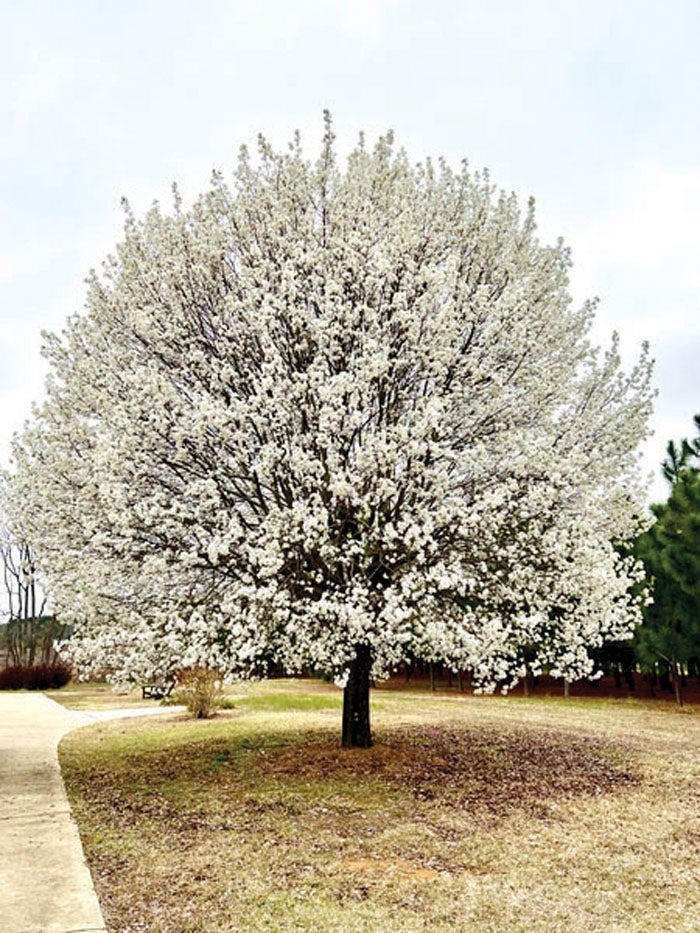Amy-Lynn Albertson: Bradford Pear: Public Enemy No. 1
Published 12:00 am Saturday, January 6, 2024

- Blooming Bradford Pear
By Amy-Lynn Albertson
N.C. Cooperative Extension
The Callery pear or Bradford pear is at the top of my list of trees you should not plant. I’ll tell you this: I have one in my backyard. Note: I did not plant this tree (it came with my house). What could I have against this fast-growing, flowerful tree that smells like cat pee? Besides the cat pee smell, of course.
Where do I begin? The Pyrus calleryana seeds were brought to the United States from China in 1916 as a possible rootstock for our pear orchards in the Pacific Northwest that were devastated by fireblight. Plant breeders noticed these trees for their ornamental properties, and the “Bradford” selection was released into the landscape industry in the early 1960s. Bradford was supposed to be seedless and sterile. That’s because its flowers can’t pollinate themselves. However, by the early 1980s, problems with “Bradford” pears began to appear, especially a tendency for older trees to break apart during windstorms or under heavy snow loads. Its branching structure was to blame, as described by horticulturist Michael Dirr (1998), “‘Bradford’ tends to develop rather tight crotches, and I have seen trees that were split in half … the plant will … fall apart because of the development of many branches around a common length of the trunk.”
Other Callery pear cultivars became popular as ornamental landscaping trees for residential and commercial use. Not only were they beautiful, fast-growing and inexpensive, but they were also highly tolerant of difficult growing conditions. In commercial areas, for example, the tree could thrive in the harsh conditions of parking lot islands and between streets and sidewalks, where temperatures were excessively high and water was scarce. As additional cultivars were introduced, they were often commercially marketed as “self-sterile” or even “seedless” — this was true as long as each cultivar was grown in isolation.
Cross-pollination between mature specimens of Callery pear cultivars is not the only way fruit production can occur. Callery pear cultivars are reproduced by vegetative propagation to keep them genetically identical. Stem cuttings of Callery pears are difficult to root, so most trees are propagated for commercial sale by grafting. In this process, the scion material of the selected cultivar is grafted onto the rootstock, which is usually P. calleryana seedlings. The two sections grow together, resulting in a tree comprising two genotypes. Occasionally, the rootstock of a planted Callery pear cultivar may develop shoots that eventually flower. In such a case, the rootstock can cross-pollinate the same tree’s upper scion, triggering fruit production. So, a wild population of pear trees can come from a landscape planting of multiple cultivars or even from a single grafted tree. By the middle of the early 2000s, thousands of young wild pear seedlings were growing undetected in the roadside vegetation across the southern and eastern United States. But as they began to flower in their third or later year, their profuse early spring blooms started to give them away. Landowners started noticing wild pears appearing in all habitats — along forest edges, wetland areas and even within forests. In addition, wild Callery pear is expected to continue to spread northward as global climate change causes shifts in warmer temperatures. Wild Callery pears have already been observed around Madison, Wisconsin, (USDA Hardiness Zone 5a), where they were thought never to survive.
So what can we do to stop the spread of wild Callery pear? First, we need to stop planting Callery pear cultivars, and those plants need to be phased out of commercial production and replaced with suitable alternatives. Second, as cultivated trees within the landscape break apart or decline, homeowners should replace them with alternatives. In many towns nationwide, Callery pears are being replaced with different tree species. Finally, suppose homeowners choose to keep cultivated Callery pears growing in their yards. In that case, they must ensure that fruits are not produced. But even if all these suggestions could be accomplished, the sad reality is that wild Callery pear will continue to be a growing problem because so many cultivars and their rootstock are already established in the landscape.
Today, the Callery pear story is another example of how even the best human intentions can go awry. The spread of wild P. calleryana into the American landscape was unanticipated and unintentional. The best we can do today is to view the Callery pear as a lesson on the importance of considering how mixing ornamental cultivars may contribute to the invasive spread of certain species. By learning from our history, we can better understand why certain species become invasive. Similarly, we can work more effectively to prevent the invasive spread of species in the future.
Amy-Lynn Albertson is director of the Rowan County Extension.




